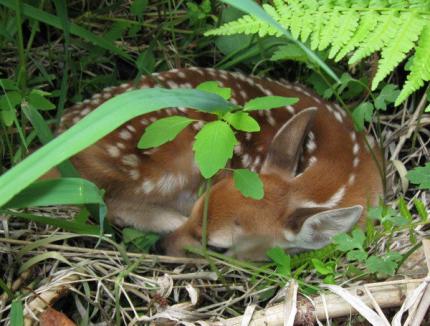
Every spring, wildlife managers and wildlife rehabilitators receive calls about “orphaned” fawns lying alone in the woods or in someone’s yard. The callers often think these fawns have been abandoned. But unless you are certain the mother is dead or the fawn is clearly sick or injured, please leave it alone.
The mother is usually foraging nearby and will return to take care of her fawn once you move away. For the first few weeks of the fawn’s life, the doe keeps the fawn hidden, except when suckling. A fawn will instinctively lie low not moving while waiting for its mother to return.
The doe may feed and bed down a considerable distance from the fawn’s safe site. This way, even if a predator detects the doe, the fawn may still have a chance of avoiding detection. Fawns do not give off an odor at this young age and will go undetected by a predator.
When to call a permitted wildlife rehabilitator
Contact a wildlife rehabilitator:
- When you are certain the mother is dead.
- When a fawn appears weak, ill, or injured, or its mother does not return the following day.
Do not handle a fawn until you have called a wildlife rehabilitator. If you have handled a fawn, rub an old towel in the grass and wipe the fawn to remove human scent. Using gloves, return the fawn to where it was found. Fawns can often be returned to their mothers if taken back to where they were found within 24-48 hours.
Found Injured Wildlife? Contact a local Wildlife Rehabilitator.